Watch the Video Version of this Article!
The concept of the solar hot water heater is not well known in America. However, more people in the states are starting to discover that you can use the power of the sun for more than just electricity.
There are many countries that utilize solar hot water heating systems as the main source of water heating. Israel is known for their "dud shemeshes," these are sun boilers that sit on the rooftops of apartment complexes and homes throughout the country.
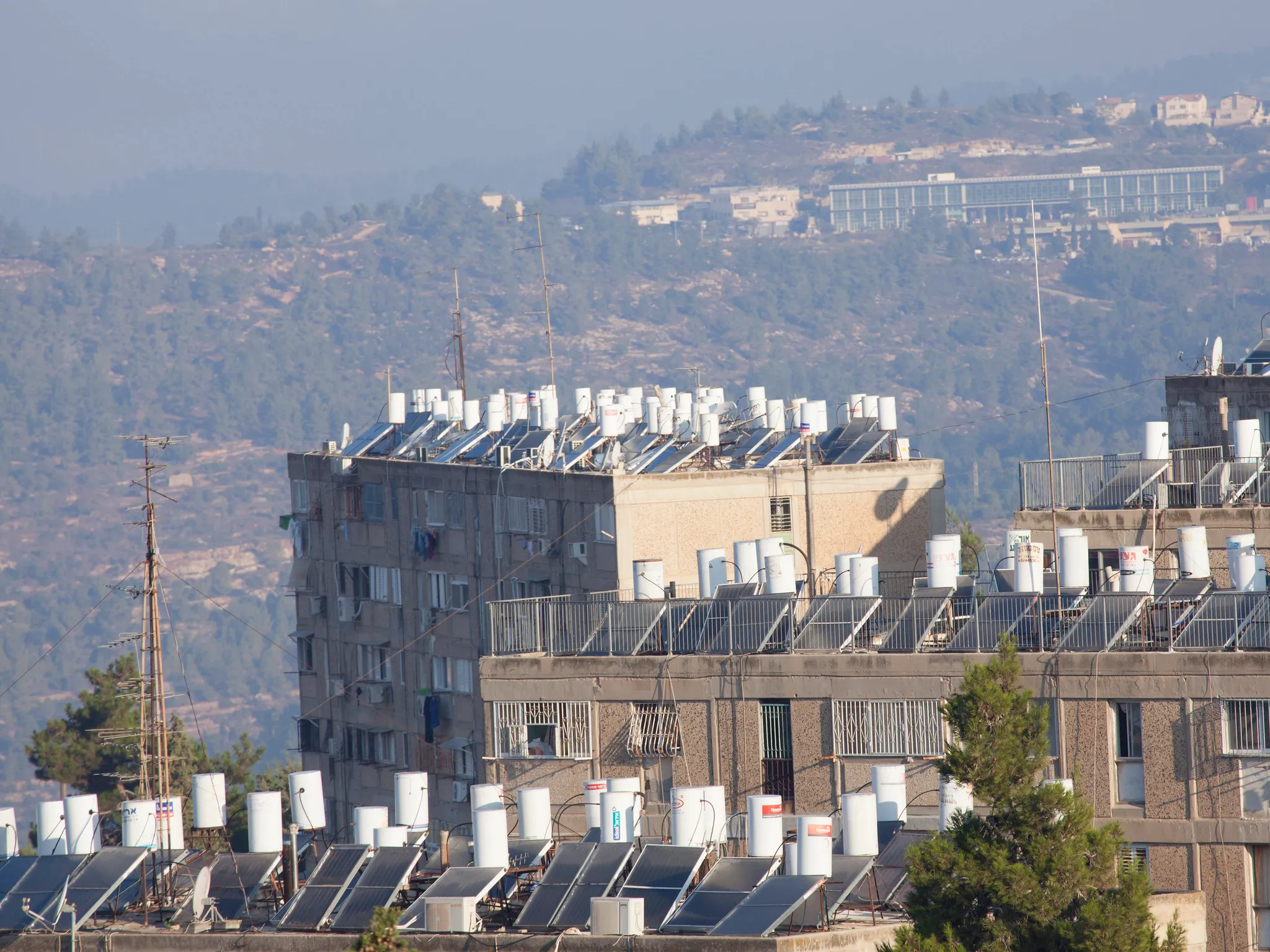
Beyond accounting for the dollars spent on heating water, when you live off the grid, you discover that electricity is a very precious resource. Anything that requires heating and cooling costs an enormous amount of energy, such as a coffee maker, which takes 3kw to make just one pot of coffee!
Let’s talk about the green aspect. The trend is to use less electricity, yet we use appliances and building materials that consume tons of energy. Why do politicians spout the rhetoric of going green, yet our mainstream methods are opposite of green?
Earth ship, anyone? But I digress.
In this guide, I give you the 101 on how to heat water using solar power methods. You will learn how solar hot water systems work, how to size a solar hot water heater, solar hot water heater off-grid methods, and if a solar hot water heater is worth it.
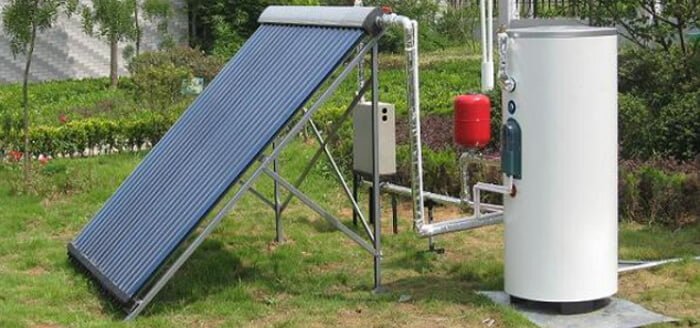
How Does a Solar Hot Water Heater Work?
In its most simplistic form, water sits in a vessel that gets heated up by the sun. These vessels are called solar collectors. Solar collectors can be simple and homemade, and can range to more complex, manufactured versions.
The hot water solar collector can be tubing, such as a copper coil. The collector can be solar thermal tubes. It can also be a batch tank, which is a large dark-colored holding tank that sits in the sun that warms up the water.
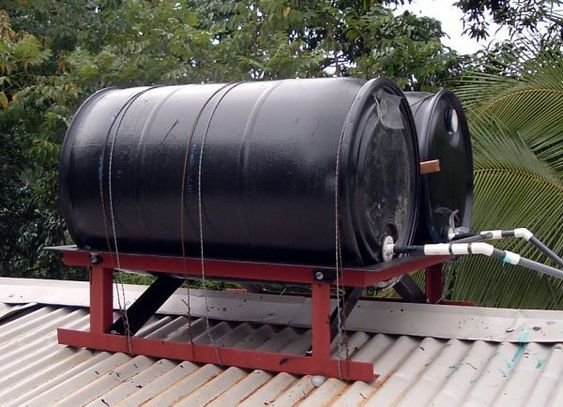
If you are using a solar batch tank, you can plumb in the tank to feed directly into your existing hot water heater. Your current water heater will only fire up when you deplete your solar batch tank. Solar collectors move the water into a holding tank, which moves the heated water to your current water heater.
I personally prefer utilizing your existing water heater with the supplementation of solar heated water, as your solar collectors will not always produce enough hot water, like on cloudy days, night time, or during the winter.
A Quick Lesson on Convection
All solar water heating systems rely on the process of convection.
Convection happens when cold water sinks and hot water rises. Cold water is denser than hot water, so it sinks to the bottom while the heated water rises to the top. The discharge port on your tank is at the top of the heater, and the cold water intake port is at the bottom.
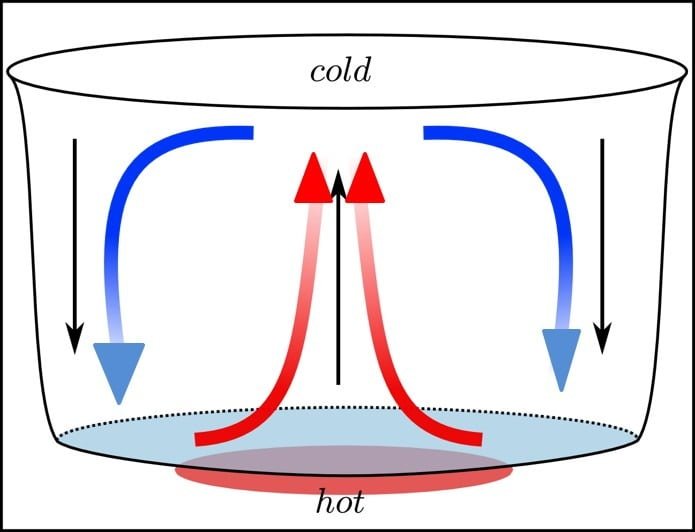
The 3 Types of Solar Hot Water Collectors
There are three main solar collector styles: solar batch water collector, flat plate solar thermal collectors, and evacuated thermal tube collectors.
Solar Batch Hot Water Collector
The solar batch hot water heater is the simplest and cheapest method and easy to DIY. Just paint a tank black, place it in direct sunlight, and solar energy does the rest. The water comes out piping hot, so be careful not to scald yourself.
Batch hot water heater collectors do not perform well in freezing climates. Although the tank itself does not tend to freeze, it's the piping that goes to and from the tank that are susceptible to freezing. You can wrap up your pipes and fittings in insulation and keep your fingers crossed that it will survive the winter.
Easy DIY Solar Hot Water Heater
- Get an old broken down hot water heater. You can find these for free at appliance shops.
- strip everything away, down to the bare tank.
- Paint the tank black.
- Place tank into a box. You can build the box with plywood or particle board.
- Line the box with reflective material. Emergency blankets do a good job.
- Put a glass panel on top of the box. An old window or sliding glass door works well. You can also use plexiglass.
- Run plumbing lines to and from the box. Route cold water in and hot water out.

Hot Tip!
Remember convection? Plumb your cold line into the bottom port lowest to the ground, and run your hot line out from the highest port.
Coiled Solar Hot Water Collectors
This type of solar hot water collector is coiled tubing that mounts as is or fits into a flat rectangular box with a glass panel affixed to the top. The coil is usually mounted to the top of the roof, similar to a solar panel.
Heated water routes to a batch tank or is plumbed directly into the water heater. Heating your hot water in coils separate from the holding tank allows for capturing the heat during the day; the heated water gets stored in a tank indoors that stays warm.
Coils are prone to freezing and may rupture. I don’t recommend using coils in places that can freeze or winterize your system during the cold months.
Think about how much volume of water the coils can hold. Unless you are actively circulating the water into a holding tank, you may find that you run out of hot water quickly.

Thermal Solar Tube Collectors
These are the most efficient solar hot water systems but are the most expensive.
The thermal tube collectors connect to a copper header that heats up in the sun. The copper header connects to a heating fin that runs down the length of a glass tube. The fin heats water efficiently. The inner tube and fin fit into a glass tube.
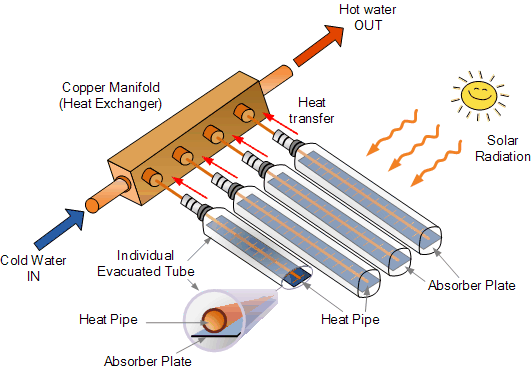
Diagram compliments of Alternative Energy Tutorials
These collectors are “evacuated” because all of the air is removed from the glass tubing. Air is what whisks heat away from water, so removing the air eliminates conductive heat loss. This is what makes thermal tube collectors so effective.
This collector style can be used in freezing climates and is still effective, regardless of the outside temperature.
How to Circulate Hot Water Without a Pump
There is a way to move hot water into your water heater or collector without a pump! Unfortunately, it is not going to work for most people, and I will tell you why.
Passive Solar Hot Water System
This type of system uses gravity and natural convection to move the water and is known as a thermosiphon system.
As the water heats up, it naturally rises. This rising effect allows the water to move in an upwards direction. In theory, you can heat water in coils and the heated water will move into the water heater or collector.
The issue with the thermosiphon design is that the coils have to be at least one foot below the holding tank. The more height, the better the flow. This means your coils have to be below your water heater by a minimum of one foot.
Most water heaters are placed on the ground in a garage or basement. You would have to put your water heater or collecting tank on a riser for the thermosiphon effect to work.
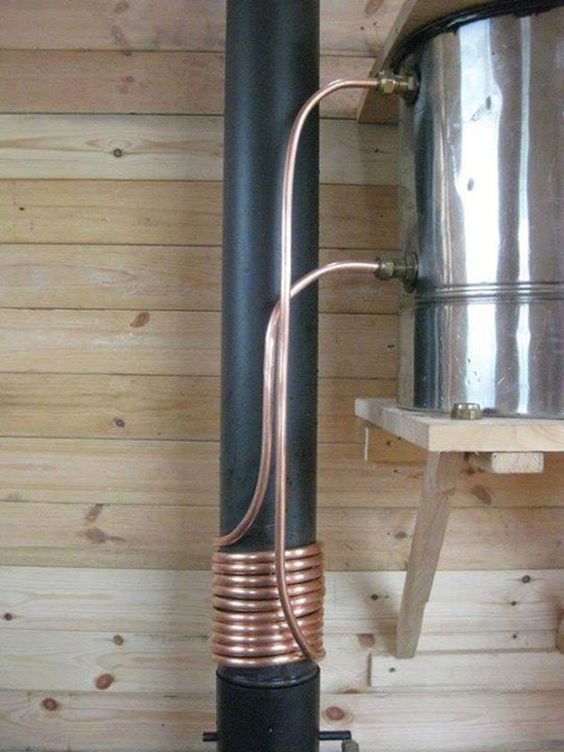
Convection, anyone?
You also have to account for bends and lengths in plumbing, as these factors affect the flow..
Mounting your coils or collector on a rooftop will not work as a passive solar hot water system.
However, there are solar collector designs with batch tank integration and could be mounted on the rooftop. Do note that the weight of these systems are really heavy, so mount accordingly! You don’t want your solar collector falling through your roof.
Active Solar Hot Water System
If your setup doesn't allow for your water tank to be above your collectors, you can use a pump to move the water instead.
This system moves the hot water from the solar water collectors to the tank with a small circulation pump. A differential controller is used to turn the pump on and off. The controller determines when the pump turns on and off by temperature. If the collector outlet temperature falls below 20 degrees, the pump turns on.
You can place your solar collectors and tank however you see fit as the pump moves the water in your system.
I personally recommend a passive hot water system so your not relying on machinery and power to pump your water. Gravity is free and never breaks down.
Now that you have decided on type of solar hot water system and whether it will be active or passive, its time to size the system for your needs.
How to Size a Solar Hot Water Heater
To calculate the size of your solar hot water system, you will need to figure out how much hot water you are using per day, per person. The average person in the USA uses about 15 gallons of hot water per day (source).
Off-Grid Pro Tip!
Learn to reduce the amount of hot water you are using! You can achieve this in many ways:
- Get a shower head with a pause button
- Reduce the number of showers you take in a week
- Turn off the hot water between soaping up dishes and rinsing dishes
- Turn off water while brushing teeth
- Wipe things down with cloths and wet wipes
Shoot, I don't even have hot water on the property right now! That's why I wrote this article, to figure out how I am going to have hot water again. When I need hot water I boil it in a kettle, like they used to do in the old days.

Pausing shower head - product link
Sizing a Batch Solar Water Tank
For a batch water heater, get a tank that matches the size of your household water use for one day. 4 people at 10 gallons would need a 40 gallon hot water tank. I would size that up by 25% for colder climates, although using a batch tank is not advised for freezing regions.
Sizing Tube, Coil, and Flate Plate Collector Solar Water Heaters
The farther north you go, the more collecting square footage you need to make enough hot water for your daily usage. Sizing your solar collector by climate:
- Sunny, non-freezing climate: 1 square foot of collector per 2 gallons of tank capacity
- Moderate climate: 1 square foot of collector per 1.5 gallons of tank capacity
- Midwest climate: 1 square foot of collector per 1 gallons of tank capacity
- Northern climate: 1 square foot of collector per 0.75 gallons of tank capacity
These figures depend on how much quantity of water your collector holds. A 3/4" coil is holding less water than a 3" flat collector. These figures are based on a standard 2" tube collector.
Let's look at an example of how all these numbers and climates work!
For our example, we are using a 60 gallon tank.
- Arizona, So. California, South Texas, Florida - 30 sq. ft. of solar collector.
- Mississippi, Arkansas, South Carolina, Tennessee - 45 sq. ft. of solar collector.
- Iowa, Nebraska, Missouri, Kansas - 60 sq. ft. of solar collector.
- Montana, Colorado, Idaho, South Dakota - 80 sq. ft. of solar collector.
As you can see, you need one and a half times more tubing in the far north than in the south. That is a huge difference. Solar hot water heating is more conducive for southern climates. Keep reading if you want to learn techniques for solar water heating in the winter.
Can You Use a Solar Hot Water Heater in the Winter?
Even down here in Arizona, I will have to winterize my coils during chilly nights. The biggest issue is freezing and bursting pipes during chilly winter nights. My plan is to place insulation over my coils at night, and remove the layer of insulation during the day.
I cover this topic extensively in my article about how to protect your solar water heater from freezing.
If you live in a climate that freezes solid for several months, you can still have a solar hot water heater. Unfortunately, the cheap DIY systems are out.
you will either need to use a thermal tube collector, a closed loop antifreeze system, or a drain-back antifreeze system. Sounds complicated, doesn't it? That's because they are!

A closed loop antifreeze system will keep your solar hot water heater running throughout the winter. However, there are a lot of parts involved and it is a complex system, so you will need to look into professional HVAC setup. Most heating contractors are knowledgeable about these types of systems as they are used in several applications like radiant heating.
The antifreeze system is designed to pump propylene glycol (a non-toxic antifreeze) around the solar collectors and the heat exchanger.
You can also look into a drain-back antifreeze system which is a simpler, and possibly more effective antifreeze system for your solar hot water heating system.
Either way, these systems are expensive, can break down, and require professional installation and mounting. I can't say its worth the cost and headache to try and heat water with the sun in the north.
Do not despair! I have written the Ultimate Guide to Off Grid Water Heaters, which gives you a ton of alternative water heating solutions for your off-grid home.
Cost of a Solar Hot Water Heater
Building a DIY solar hot water heater can cost literally nothing. You can scrounge up materials from around your property. You can paint old hoses black and let them sit in the sun. Don't forget about repurposing an old broken down water heater tank as mentioned above.
The costs mount when you purchase prefabricated solar collectors and antifreeze systems.
It isn’t all that easy to price out a solar hot water system, because most HVAC and plumbing companies want you to contact them directly to get a quote. After surfing the net for quotes, I came up with some figures for you. However, these figures will vary greatly depending on your location and contractor rates.

A passive 40 gallon hot water system in a warm climate complete with one thermal tube collector panel, the storage tank, controls, sensors, and pump station starts at $2,000. It will land more around $3,000 when including typical plumbing parts and pieces. These figures does not even include installation, which is estimated to start at $2,000.
An active 40 gallon hot water system built with the antifreeze components for cold climate is going to run you about $4,000. Expect to tack on another $4,000 for installation costs.
There is a 25% tax rebate program which will knock off thousands of dollars for your prefabricated solar hot water heater. You need to make sure that the system is SRCC certified. You can also check with your local county and state for more rebates and incentives.
How Much Money Will You Save Running a Solar Hot Water Heater?
The average cost of running a standard electric hot water heater is about $600 per year. The average cost of running an active prefabricated solar hot water heater system per year is $100 (Source). The cost of running a DIY passive solar water heater is zero.
You will save about $500 per year on electricity which adds up to $5,000 of savings over ten years This will pretty much pay off a professionally installed prefabricated system in a warm climate. This figure does not account for electricity price hikes or breakdowns in the hot water heater system.
Solar Hot Water Heaters for Sale
Most solar water heaters are sold through solar installers. You have to call or visit their website to get a quote.
The prefabricated ones are not easy to come by online, but I have a few links to share with you.
Active Evacuated Vacuum Tube Single Coil Hot Water Heater With Holding Tank
Duda makes this prefabricated hot water heater setup that looks pretty legit. Its a few thousand bucks and you can install it yourself.
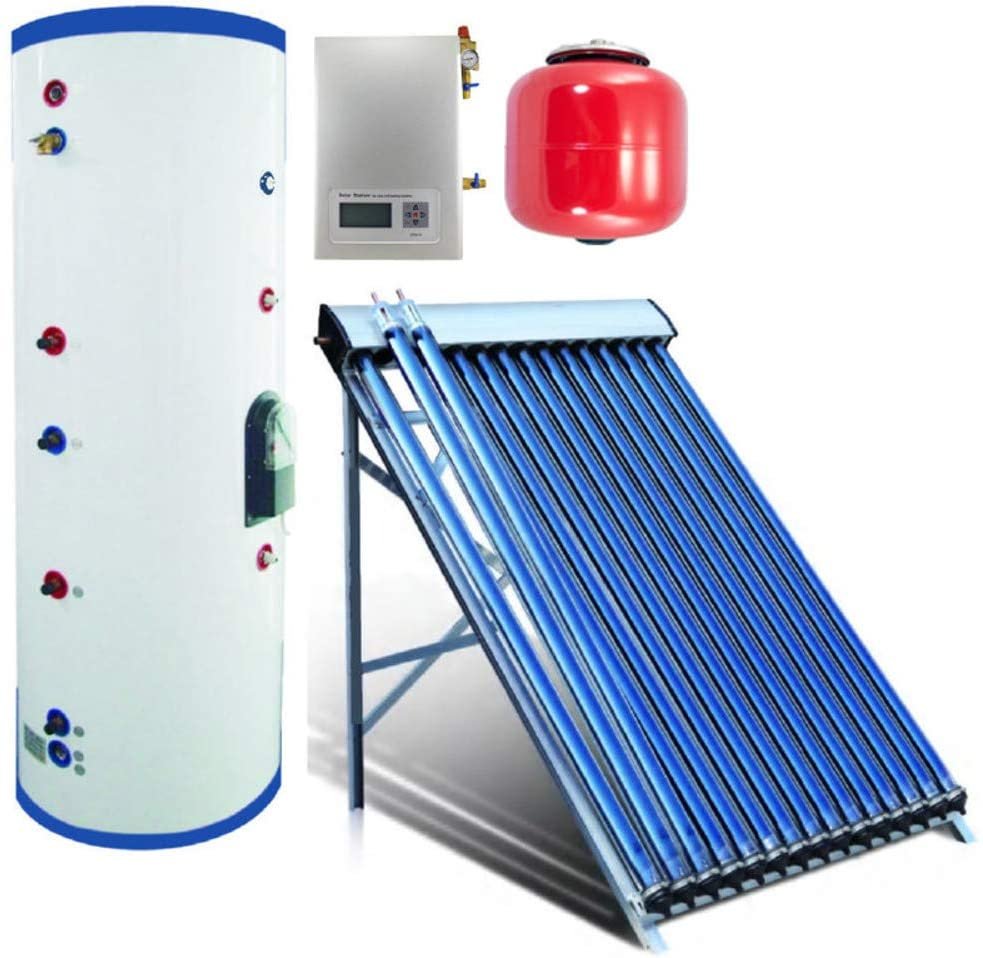
You can also buy the vacuum tube collector and frame separately.

What are Solar Water Heating Panels?
A solar hot water heating panel is black coiled tubing placed into a panel that mounts much like a solar panel would. Essentially, its a solar panel, but heats up water instead of catching energy.
Most solar water heating panels you see are DIY. All you need is a frame to put the coils into and fit a glass or plexiglass over the top.
How to Build a Solar Water Heating Panel
This is a pretty basic DIY build that most anyone can do with repurposed materials and some basic tools.
Step One - Build a frame for your tubing. A four by four frame is a good standard size.
Step Two - Coil up 1/2 inch poly tubing. You can also use copper tubing.
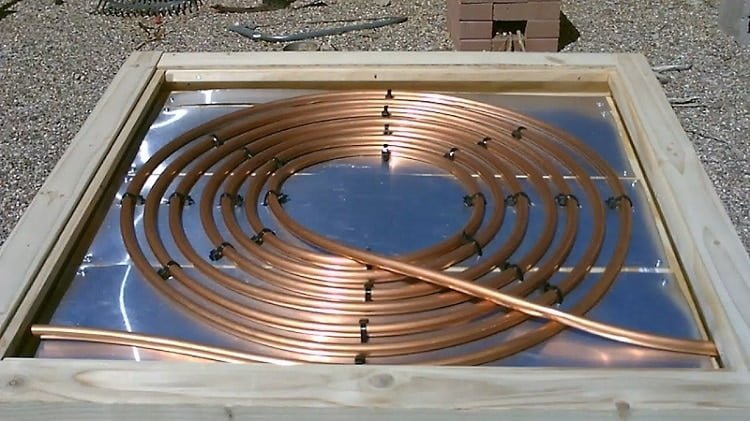
Step Three - Add insulation into the frame.
Step Four - Lay the tubing on the bed of insulation.
Step Five - Add a glass panel or plexiglass over the tip.
You can place your solar water heating panels on a rooftop which will require a circulation pump, or place them on a ground and let natural convection move your water into a holding tank.
Pros and Cons of Solar Hot Water Systems
Reasons you want a solar hot water system:
- You will save on your energy bill
- Its environmentally friendly
- You can build a solar hot water heater for practically free
- You can install a hot water system anywhere
- You can build a system that doesn’t rely on machinery
The cons of a solar hot water heater are:
- You need the sun to shine for hot water
- Active systems have parts that can break down
- Prefabricated water systems are complex and expensive
- You can’t use most models in northern climates
I cover even more advantages and disadvantages of solar hot water heaters here.
Solar Hot Water Heater Conclusion
I don't think it really makes sense to use a solar hot water heater in the north. The expense to purchase a prefabricated one that runs antifreeze through the system just doesn't seem worth the payoff.
You can build a DIY solar water heater and use it for a few months, then wrap it up in the winter and use a conventional hot water heater.
Even in the south, you need to protect your equipment from freezing overnight. You can use a planket, which is a plant blanket that is used to protect crops from freezing. Cover your equipment at night and then remove the planket during the day.
Your only going to have hot water when the sun is shining on your collectors. It will take time for them to warm up. Pumping the hot water from solar collectors to an existing hot water heater is the smartest option if you want continuous hot water.
Recommended Reading: Tankless Propane Water Heaters for Off Grid Living.

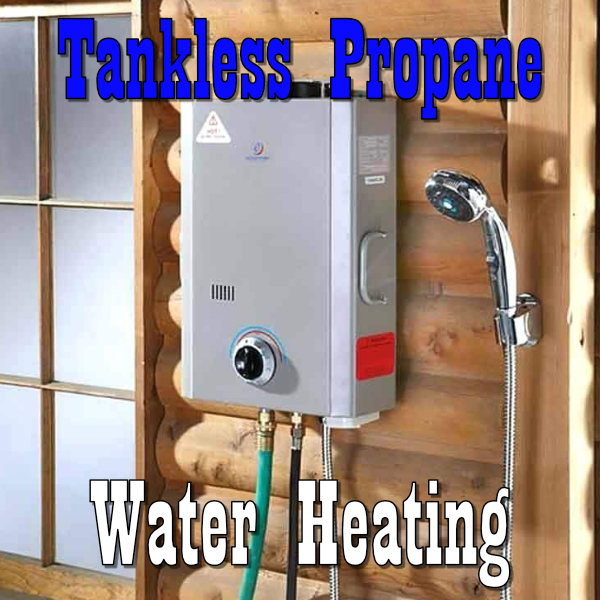
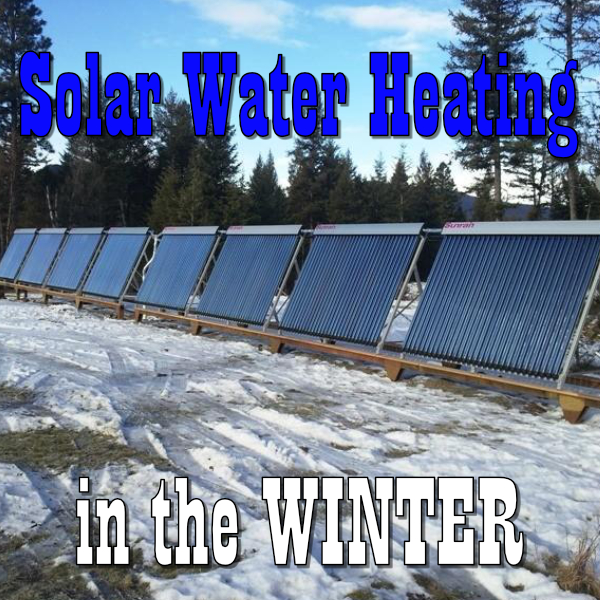
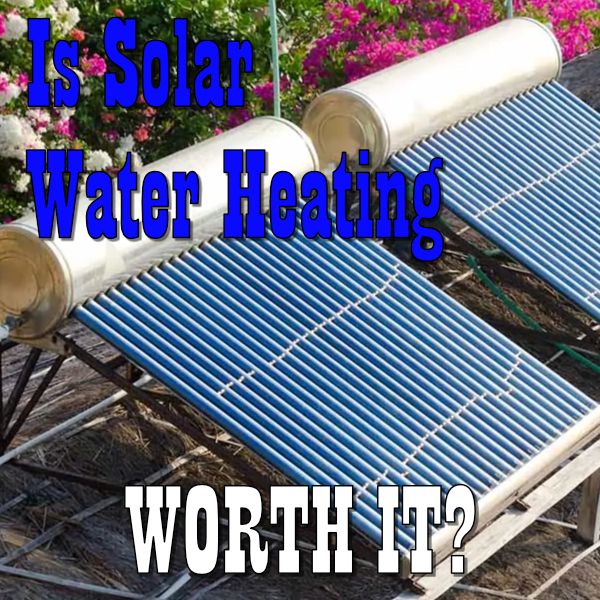
great, information post thank you 🙂
You are most welcome 🙂